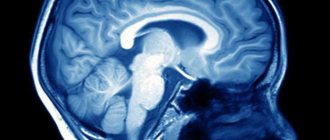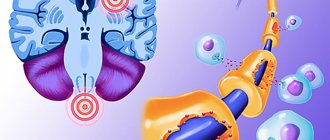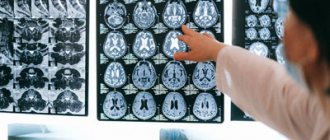The most common complaint that doctors hear from their patients is headache. Both adults and children complain about it. It is impossible to ignore this. Especially if there are other symptoms. Parents should pay special attention to the child’s headaches and the baby’s behavior, because he cannot say that he is in pain. Perhaps these are the consequences of a difficult birth or congenital anomalies, which can be determined at an early age. Maybe these are liquorodynamic disturbances. What is it, what are the characteristic signs of this disease in children and adults and how to treat it, we will consider further.
What does liquorodynamic disturbances mean?
Liquor is cerebrospinal fluid that constantly circulates in the ventricles, cerebrospinal fluid ducts and in the subarachnoid space of the brain and spinal cord. Liquor plays an important role in metabolic processes in the central nervous system, in maintaining homeostasis in brain tissue, and also creates a certain mechanical protection for the brain.
Liquorodynamic disorders are conditions in which the circulation of cerebrospinal fluid, its secretion and reabsorption are impaired. These processes are regulated by glands located in the choroid plexuses of the brain ventricles that produce fluid.
In the normal state of the body, the composition of the cerebrospinal fluid and its pressure are stable.
Main precedents of violations
Among them are congenital and acquired. Congenital ones include:
- Genetic failure of intrauterine development;
- Structural pathologies leading to disruption of connections between the hemispheres of the brain;
- The appearance of congenital neoplasms that can replace the ventricles of the brain;
- Arnold-Chiari and Dandy-Walker syndromes.
Acquired causes include:
- Consequences of traumatic effects on the brain and spinal cord;
- Intracranial formation obstructing normal outflow;
- Inflammatory and infectious processes in the tissues of the brain or spinal cord;
- Thrombotic formations.
The mechanism of occurrence of pathology
The main mechanism for the development of liquorodynamic disorders is a violation of the ratio of the volume of cerebrospinal fluid produced over the volume of its absorption. The process of cerebrospinal fluid production will depend on the state of the natural barrier between it and the bloodstream. As a result, through transfusion through the walls of biological barriers, plasma exits the blood into the cerebrospinal fluid.
Since the space where it is located is quite limited, when the quantity increases, compression of the structures of the central nervous system begins to occur. As a result of such changes, neurological symptoms appear. In some cases, a pathological clinic may develop against the background of normal cerebrospinal fluid production. But at the same time there is a violation of its outflow from the cavities of the brain. Another mechanism is the slowing down of the absorption of the substance into the brain structures.
What is the mechanism of violations
Let's consider how liquorodynamic disorders of the brain can develop:
- The rate of production and release of cerebrospinal fluid by the choroid plexuses increases.
- The rate of absorption of cerebrospinal fluid from the subarachnoid space slows down due to the blocking of the narrowing of the cerebrospinal fluid vessels due to previous subarachnoid hemorrhages or inflammatory diseases of the meninges.
- The rate of CSF production decreases during the normal absorption process.
The rate of absorption, production and release of cerebrospinal fluid is influenced by:
- On the state of cerebral hemodynamics.
- State of the blood-brain barrier.
The inflammatory process in the brain increases its volume and increases intracranial pressure. The result is poor circulation and blockage of the vessels through which the cerebrospinal fluid moves. Due to the accumulation of fluid in the cavities, partial death of intracranial tissue may begin, and this will lead to the development of hydrocephalus.
Prevention of violations
This is one of the most important stages aimed at preventing not only liquorodynamic disorders, but also complications associated with them.
First of all, this is to prevent the development of the congenital form of this disease. If family members have hereditary pathologies, especially those related to circulatory disorders or developmental defects of various organs, it is necessary to consult a geneticist for advice. This is necessary to exclude the possible transmission of disorders associated with genetic mutations transmitted by inheritance.
As well as careful pre-conception preparation of a woman to prevent the development of inflammatory diseases at the stage of bearing a child.
Among the measures to prevent acquired conditions, the following should be highlighted:
- Prevention of infectious inflammatory diseases associated with damage to the nervous system.
- Monitor the state of the blood coagulation system, avoid hypercoagulation and stressful situations, as well as surges in blood pressure.
- Monitor your posture and prevent the development of osteochondrosis, especially in the cervical spine. To do this, you regularly need to carry out physical exercises aimed at strengthening your muscles. When working in a forced position of the body, take regular breaks to relax muscle fibers, as well as prevent stagnation.
Classification of violations
Liquorodynamic disorders are classified in the following areas:
- How does the pathological process proceed:
- Chronic course.
- Acute phase.
2. Stages of development:
- Progressive. Intracranial pressure increases and pathological processes progress.
- Compensated. Intracranial pressure is stable, but the ventricles of the brain remain dilated.
- Subcompensated. Great danger of crises. Unstable condition. Blood pressure can rise sharply at any moment.
3. In which cavity of the brain is the cerebrospinal fluid located:
- Intraventricular. Fluid accumulates in the ventricular system of the brain due to obstruction of the cerebrospinal fluid system.
- Subarachnoid. Liquorodynamic disturbances of the external type can lead to destructive lesions of brain tissue.
- Mixed.
4. Depending on the pressure of the cerebrospinal fluid:
- Hypertension. Characterized by high intracranial pressure. The outflow of cerebrospinal fluid is impaired.
- Normotensive stage. Intracranial pressure is normal, but the ventricular cavity is enlarged. This condition is most common in childhood.
- Hypotension. After surgery, excessive outflow of cerebrospinal fluid from the ventricular cavities.
Causes of liquorodynamic disorders
As a rule, this disease occurs due to inflammatory processes that occur in the brain tissue. A spinal cord injury may also be involved - this fact plays an important role when compiling an anamnesis. Liquorodynamic disturbances can appear as a result of back injuries; very often patients suffer from intracranial hypertension after traumatic brain injury; the cause may be a tumor, as well as diseases (parasitic) of the central nervous system. Liquorodynamic disorders can develop in a person who has congenital pathologies in the formation of the brain, as well as the spinal cord.
Causes congenital
There are congenital anomalies that can contribute to the development of liquorodynamic disorders:
- Genetic disorders in intrauterine development of the fetus.
- Agenesis of the corpus callosum.
- Dandy-Walker syndrome.
- Arnold-Chiari syndrome.
- Encephalocele.
- Stenosis of the cerebral aqueduct, primary or secondary.
- Porencephalic cysts.
Acquired reasons
Liquorodynamic disorders can begin to develop for acquired reasons:
- Spinal cord and brain injuries.
- Various infectious diseases and parasitic infections that affect the nervous system.
- Neoplasms inside the skull that block the cerebrospinal fluid pathways.
- Thrombosis.
- Intrauterine hypoxia in the first two days after birth.
- Papillomas of the choroid plexus.
2. Reasons
Disturbances in the secretion and/or absorption of cerebrospinal fluid, irritation or, conversely, decreased activity of the choroid plexuses can lead to both hyper- and hypotension of the cerebrospinal fluid. Common causes of liquorodynamic disorders also include:
- severe injuries, incl. neurosurgical, with liquorrhea (open leakage of cerebrospinal fluid outward, into the nasopharynx or other body cavities);
- chronic inflammatory processes with the formation of a cerebrospinal fluid fistula;
- complicated oncological processes in late stages;
- anomalies of anatomical development;
- the presence of parasites in structures associated with the central nervous system.
Visit our Neurology page
Symptoms of disorders in infants
Liquorodynamic disorders in children under one year of age have the following symptoms:
- Frequent and profuse regurgitation.
- Unexpected crying for no apparent reason.
- Slow overgrowth of the fontanel.
- Monotonous crying.
- The child is lethargic and sleepy.
- Sleep is disturbed.
- Seams coming apart.
Over time, the disease progresses more and more, and signs of liquorodynamic disorders become more pronounced:
- Tremor of the chin.
- Twitching of limbs.
- Involuntary shudders.
- Life support functions are disrupted.
- Disturbances in the functioning of internal organs for no apparent reason.
- Possible squint.
Visually, you can notice the vascular network in the area of the nose, neck, and chest. When crying or tense muscles, it becomes more pronounced.
The neurologist may also note the following signs:
- Hemiplegia.
- Extensor hypertonicity.
- Meningeal signs.
- Paralysis and paresis.
- Paraplegia.
- Graefe's symptom.
- Nystagmus is horizontal.
- Delay in psychomotor development.
You should visit your pediatrician regularly. At the appointment, the doctor measures the volume of the head, and if pathology develops, changes will be noticeable. So, there may be such deviations in the development of the skull:
- The head grows quickly.
- It has an unnaturally elongated shape.
- The large and small fontanelles swell and pulsate.
- Sutures are coming apart due to high intracranial pressure.
All these are signs that a syndrome of liquorodynamic disorders is developing in an infant. Hydrocephalus progresses.
I would like to note that it is difficult to determine liquorodynamic crises in infants.
Health - medical portal of Azerbaijan
One of the causes of headaches is liquorodynamic disorders. When a liquorodynamic crisis occurs in children, they cannot accurately convey their sensations, which significantly complicates the doctor’s task.
Things are bad for children under one year old. Children can only scream to notify others that something is bothering them. But what exactly? Understanding this is a difficult task for doctors and parents.
* The syndrome of liquorodynamic disorders is a pathological condition of the body in which the secretion, circulation and resorption of cerebrospinal fluid (CSF) washing the brain is impaired. The disease develops in a hypertensive or hypotensive type and is characterized by severe headaches and frequent crises.
Causes
Liquorodynamic disorders can be congenital or acquired. Congenital anomalies that provoke the development of changes in the circulation of cerebrospinal fluid include the following brain anomalies: - Arnold-Chiari malformation; - Dandy-Walker malformation; - primary or secondary stenosis of the cerebral aqueduct; - agenesis of the corpus callosum; - genetic disorders in the X chromosome; - encephalocele; - porencephalic cysts; - trisomy on chromosomes 13, 18, 9. The list of causes of acquired triggers includes the following anomalies: - Intrauterine hypoxia, leading to intracranial hemorrhage in the first 48 hours after birth. — Injuries to the brain and spinal cord. - Tumors and cysts of the brain that block the cerebrospinal fluid pathways. — Infectious and parasitic diseases affecting the nervous system. — Thrombosis of veins and sinuses. - Papilomas of the choroid plexus.
* During pregnancy, a screening ultrasound of the fetus is performed at 18-20 weeks. During this period, it is already possible to examine the brain and liquor system of the unborn child. This makes it possible to draw a conclusion about the presence or absence of brain pathology in the fetus.
Features of clinical symptoms in children of the first year of life
In children under one year of age with cerebrospinal fluid circulation disorders, parents note frequent and profuse regurgitation, very slow overgrowth of fontanelles, suture dehiscence, spontaneous crying for no reason, after which the children become lethargic and drowsy. As the disease develops, the symptoms also increase, including twitching of the limbs, tremor of the chin, and involuntary shuddering of the baby. It is very important for children under one year old to regularly visit the pediatrician. During the examination, the doctor, during the examination, measures the circumference of the child's head. Normally, the volume of the head increases by 6-7 cm in the first 3 months, and by 0.5-1 cm per month from the fourth month to one year. In the presence of pathological changes, the head grows very quickly and takes on an unnaturally elongated shape, usually in anteroposterior dimensions. The large and small fontanelles in such infants do not close, but rather swell and pulsate. Due to increased intracranial pressure and the plasticity of the connective tissue, the sutures separate. Thanks to this, children remain in the compensation stage for a long time. Increasing hydrocephalus is a clear sign of impaired cerebrospinal fluid dynamics. When examined by a neurologist, focal neurological symptoms are noted: paralysis and paresis, para- and hemiplegia, extensor hypertonicity, nystagmus, Graefe's symptom, meningeal signs. Young patients are characterized by monotonous crying and their sleep is often disturbed. In the area of the bridge of the nose, neck, and upper chest in sick children, a vascular network is pronounced, which becomes visible when the child tenses (crying, trying to raise his head, sit down). In young patients, it is difficult to identify liquorodynamic crises. Children under one year of age may experience disorders of internal organs without objective reasons. Vital functions are impaired. Over time, such children begin to lag significantly behind in psychomotor development. Sometimes a mother’s attention is attracted by the child’s growing squint. An experienced ophthalmologist may already suspect a syndrome of liquorodynamic disorders based on changes in the fundus of the eye.
Clinic for children after one year
After the child’s skull has fully formed and the fontanelles have closed, the sutures have ossified, and symptoms of increased intracranial pressure begin to predominate. Children complain of headaches, apathy, followed by anxiety, impaired coordination of movements, gait, and speech. Liquorodynamic headache occurs in attacks, often in the morning, and may be accompanied by nausea and vomiting. There is no relief after vomiting. Such children have poor vision, horizontal nystagmus is noted, and due to muscle paralysis they cannot look up. In severe cases, the “bobble doll head” symptom is observed. Increased symptoms are called “liquid dynamic crises.” If the disease occurs at an early age, children speak poorly or do not speak at all. Changes in mental development from minimal to extreme idiocy. Such children use standard memorized phrases in their speech, often without understanding their meaning. They are always in a good mood. Children also have disorders of the endocrine system, most often they manifest themselves in the form of obesity and delayed sexual development. Over time, convulsive syndrome increases in young patients.
Diagnostics
In children under one year of age, the diagnosis of liquorodynamic disorders consists of collecting a pregnancy history, parental complaints, examining the child by specialists (neurologist, ophthalmologist), fundus examinations, and instrumental studies, including ultrasound, magnetic resonance imaging, neurosonography, computed tomography.
In children over one year of age, complaints are also collected for diagnosis, examined by specialists, and MRI and CT are used from instrumental studies.
Treatment
The treatment method is chosen based on etiological factors, the patient’s age, and the presence of concomitant pathology. There are medicinal and surgical types of therapy. Drug therapy is used to reduce the volume of circulating cerebrospinal fluid, its formation, and reduce intracranial volume. For this purpose, Diacarb and Furosemide are prescribed. These drugs are often used in neonatal practice, despite the risk of complications. To achieve maximum effect, drugs are combined in different dosages. Steroids are also used. Their action in this situation is aimed at reducing cerebral edema. The decision to perform surgical treatment is made if it is necessary to reduce intracranial action and reduce neurological symptoms. Indications for surgical treatment:
— occlusive form of hydrocephalus, confirmed by MRI data; - lack of effect from drug treatment; — liquorodynamic crisis. In each case, the decision about surgical intervention is made individually.
www.bakumedinfo.com
Signs of liquorodynamic disorders in children after one year
After one year, a child’s skull is already formed. The fontanelles have completely closed and the sutures have ossified. If there are liquorodynamic disturbances in a child, signs of increased intracranial pressure appear.
There may be such complaints:
- Headache.
- Apathy.
- Worry for no reason.
- Nausea.
- Vomiting, after which there is no relief.
The following signs are also characteristic:
- Gait and speech are impaired.
- There are disturbances in the coordination of movements.
- Vision decreases.
- Horizontal nystagmus.
- In advanced cases, “bobble doll head”.
And also, if liquorodynamic disorders of the brain progress, the following deviations will be noticeable:
- The child speaks poorly.
- They use standard, memorized phrases without understanding their meaning.
- Always in a good mood.
- Delayed sexual development.
- Convulsive syndrome develops.
- Obesity.
- Disturbances in the functioning of the endocrine system.
- Lag in the educational process.
Symptoms of liquorodynamic disorders
With disorders that cause high blood pressure, patients usually suffer from severe headaches, which may be accompanied by a lack of appetite and even vomiting. Headaches tend to get worse when you sneeze or cough. Dizziness and bradycardia may also occur.
With liquor hypotension, a person also has a symptom such as headache, but it manifests itself mainly in the crown area. A sudden coughing attack or sudden movements can increase the pain. In such conditions, the patient experiences relief by being in a supine position, with his head down.
Diagnosis of the disease in adults
If you experience headaches and the symptoms described above, you should consult a neurologist. To clarify the diagnosis and prescribe treatment, the following studies may be prescribed:
- Computed tomography.
- Angiography.
- Pneumoencephalography.
- ECHO of the brain.
- NMRI.
If there is a suspicion of a syndrome of cerebrospinal fluid dynamics disorders, a lumbar puncture may be prescribed with a change in cerebrospinal fluid pressure.
When diagnosing adults, much attention is paid to the underlying disease.
Diagnosis of liquorodynamic disorders
As everyone knows, a timely diagnosis is the first step on the path to healing. However, it is important to take into account that you need to seek professional help from an experienced doctor who will be able to make the correct diagnosis and prescribe appropriate treatment without causing harm to the patient’s health. As a rule, the diagnosis of liquorodynamic disorders is made using a lumbar puncture with the conversion of cerebrospinal fluid pressure. You will also be prescribed a computed tomography scan of the brain, ECHO-EG (echoencephalography), NMRI (nuclear magnetic resonance imaging), angiography and pneumoencephalography. Only after carrying out all these manipulations can the doctor make a correct diagnosis and begin treatment of the patient.
Treatment of liquorodynamic disorders
The earlier the disease is detected, the greater the chance of restoring lost brain functions. The type of treatment is selected based on the presence of pathological changes in the course of the disease, as well as the age of the patient.
In the presence of increased intracranial pressure, diuretics are usually prescribed: Furosemide, Diacarb. Antibacterial agents are used in the treatment of infectious processes. Normalization of intracranial pressure and its treatment is the main task.
To relieve swelling and inflammation, glucocorticoid drugs are used: Prednisolone, Dexamethasone.
Steroid medications are also used to reduce cerebral edema. It is necessary to eliminate the cause of the disease.
As soon as liquorodynamic disturbances are detected, treatment should be prescribed immediately. After undergoing complex therapy, positive results are noticeable. This is especially important during the period of child development. Speech improves, progress in psychomotor development is noticeable.
Surgical treatment is also possible. It may be prescribed in the following cases:
- Drug treatment is ineffective.
- Liquorodynamic crisis.
- Occlusive hydrocephalus.
Surgical treatment is considered for each case of the disease separately, taking into account age, characteristics of the body and the course of the disease. In most cases, surgery on the brain is avoided so as not to damage healthy brain tissue, and complex drug treatment is used.
It is known that if the syndrome of liquorodynamic disorders in a child is not treated, the mortality rate is 50% up to 3 years, 20-30% of children survive to adulthood. After surgery, mortality is 5-15% of sick children.
Mortality increases due to late diagnosis.
3. Symptoms and diagnosis
CSF hypertension syndrome usually manifests itself as intense headaches of various localizations (especially in the morning), dizziness, specific nausea (even to the point of vomiting), meningeal signs (symptoms inherent in inflammation of the meninges).
With cerebrospinal fluid hypotension, most patients note parieto-occipital localization of pain, which is provoked or aggravated by sudden movements of the head.
Liquorodynamic disorders are diagnosed clinically, during a standard neurological interview, examination and study of reflexes. As necessary (for example, if a tumor process, cystic formation, etc. is suspected), additional instrumental studies are prescribed, usually tomographic, and a puncture is performed to collect cerebrospinal fluid for laboratory analysis.
About our clinic Chistye Prudy metro station Medintercom page!
Prevention of liquorodynamic disorders
Preventive measures include:
- Observation of pregnancy in the antenatal clinic. It is very important to register as early as possible.
- Timely detection of intrauterine infections and their treatment.
At 18-20 weeks, an ultrasound shows the development of the fetal brain and the state of the unborn child’s cerebrospinal fluid. At this time, it is possible to determine the presence or absence of pathologies.
- The right choice of delivery.
- Regular monitoring by a pediatrician. Measuring the circumference of the skull, if there is a need to conduct a fundus examination.
- If the fontanel does not close in a timely manner, it is necessary to conduct neurosonography and consult a neurosurgeon.
- Timely removal of tumors that block the cerebrospinal fluid pathways.
- Regular observation by a doctor and carrying out the necessary studies after suffering injuries to the brain and spinal cord.
- Timely treatment of infectious diseases.
- Prevention and therapy of chronic diseases.
- Quit smoking and alcohol.
- It is recommended to play sports and lead an active lifestyle.
It is easier to prevent any disease or take all measures to reduce the risk of developing pathology. If liquorodynamic disorders are diagnosed, then the earlier therapy is started, the greater the chance that the child will develop normally.








